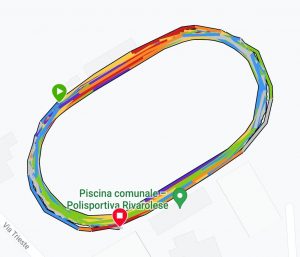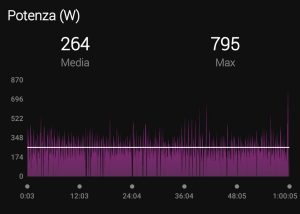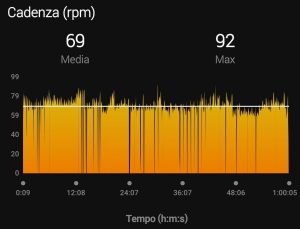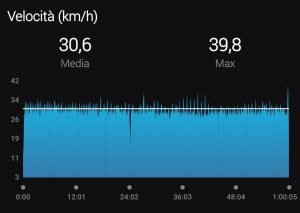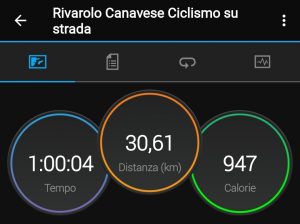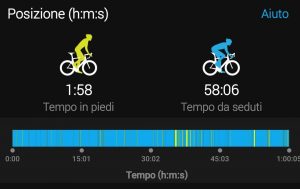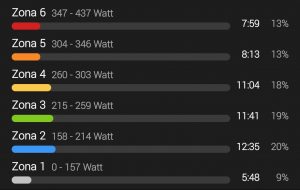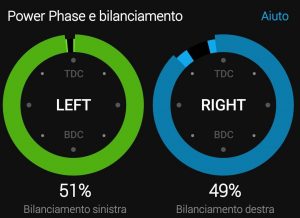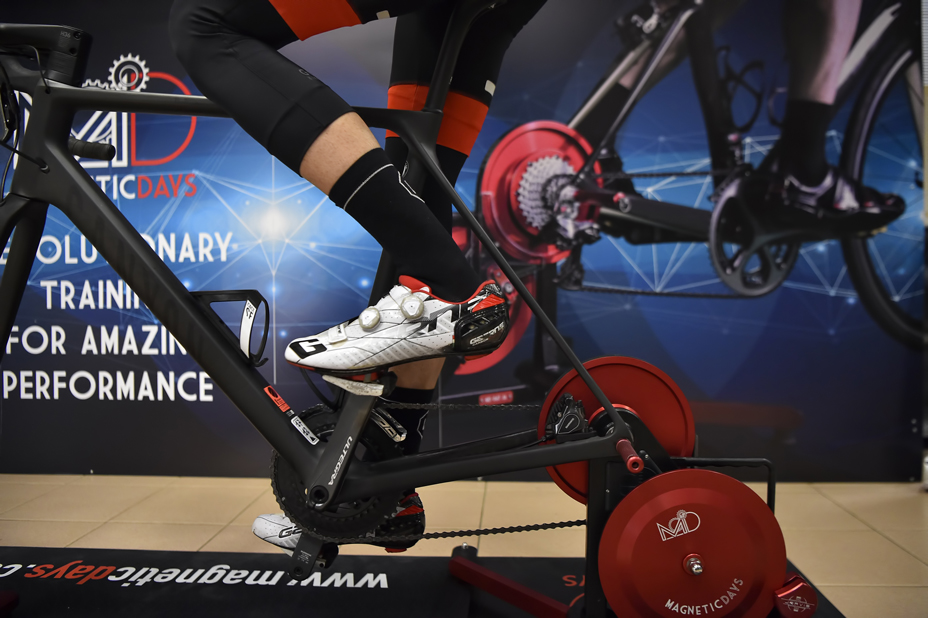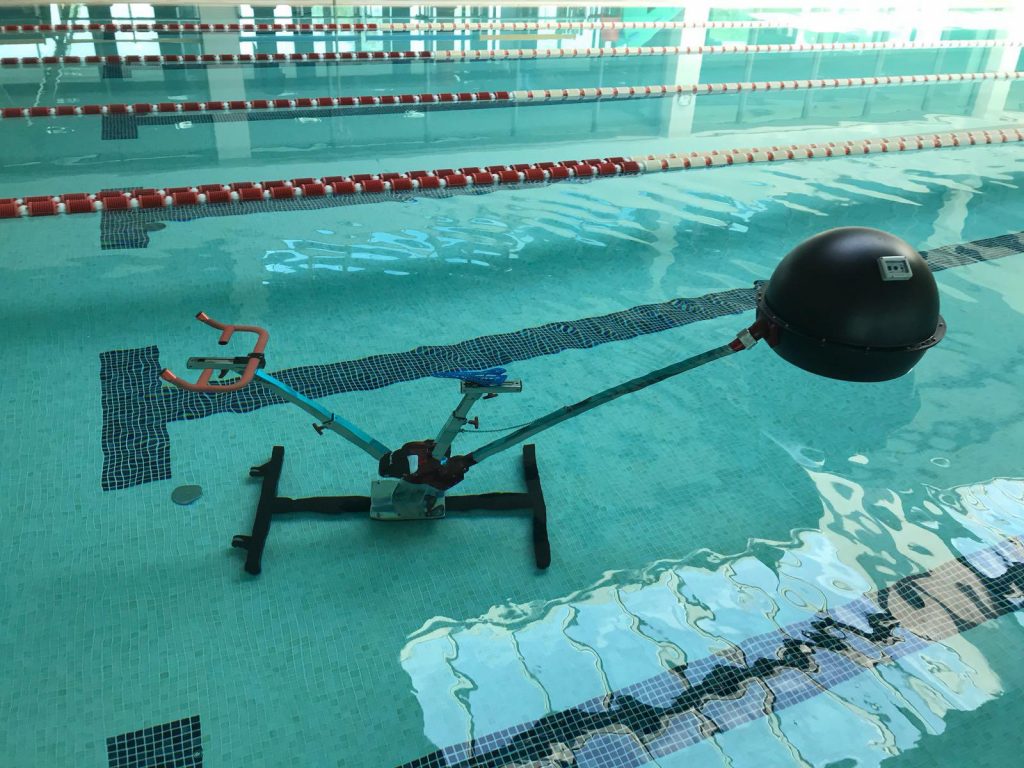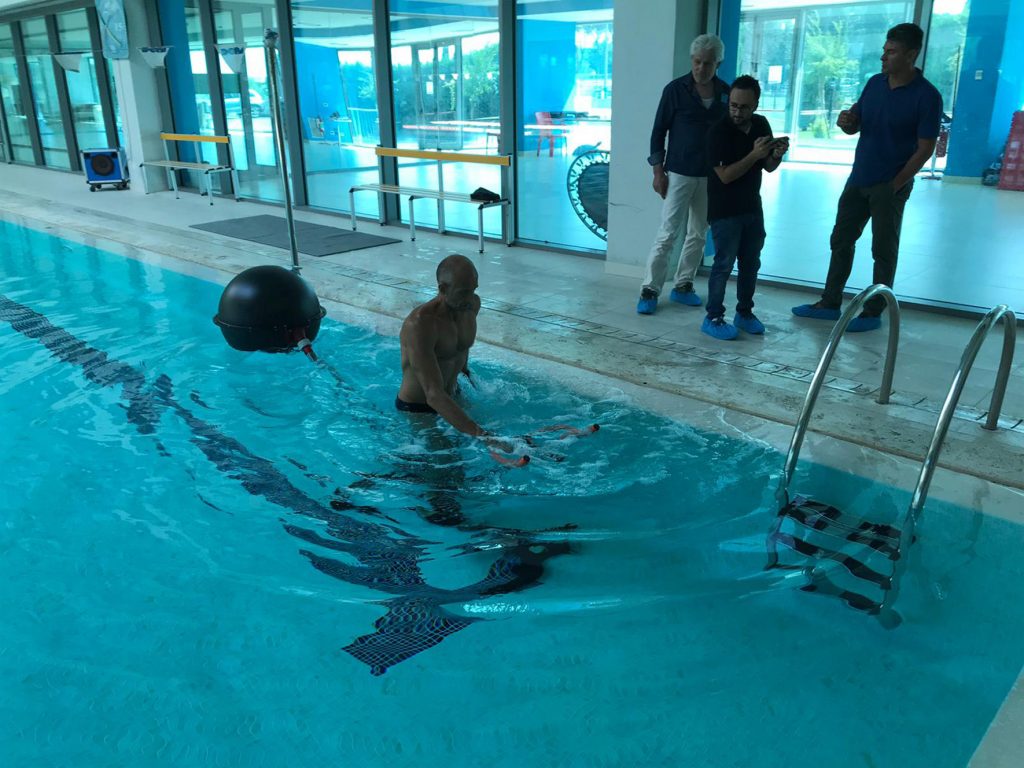On Sunday May 30th, Colonel Carlo Calcagni established a new track record with FORZA PURA independent bike cranks, approved by the judges of the Italian Athletics Federation, at the Centro Polisportivo in Rivarolo Canavese (Turin). A sporting event that wanted to focus on issues related to sport for the disabled and also aimed at letting people know about the association “PIU ‘GIRI PIU’ VIVI – SPORT FOR ALL” (the more you ride, the more you live) which organized the Giro d’Italia Solidale, a non competitive triathlon race, composed of 47 stages, that allow people with disabilities to participate as athletes.
The story of Colonel Calcagni is inextricably linked to his love for his homeland. At the age of 28, in the mid 1990s, Carlo was already an experienced helicopter pilot of the Italian Army, deployed in the Balkans with the international contingent, under the UN peacekeeping operations. Assigned to the MEDEVAC (medical evacuation) service, he engaged in numerous recovery missions for wounded soldiers and civilians. During the course of these activities, he was exposed to heavy metal nanoparticles formed after the explosion of devastating devices. These heavy metal cells entered his body taking over healthy cells and impacting him both physically and neurologically. “Every day is a fight for life – the Colonel says – that’s why my motto is NEVER GIVE UP”.
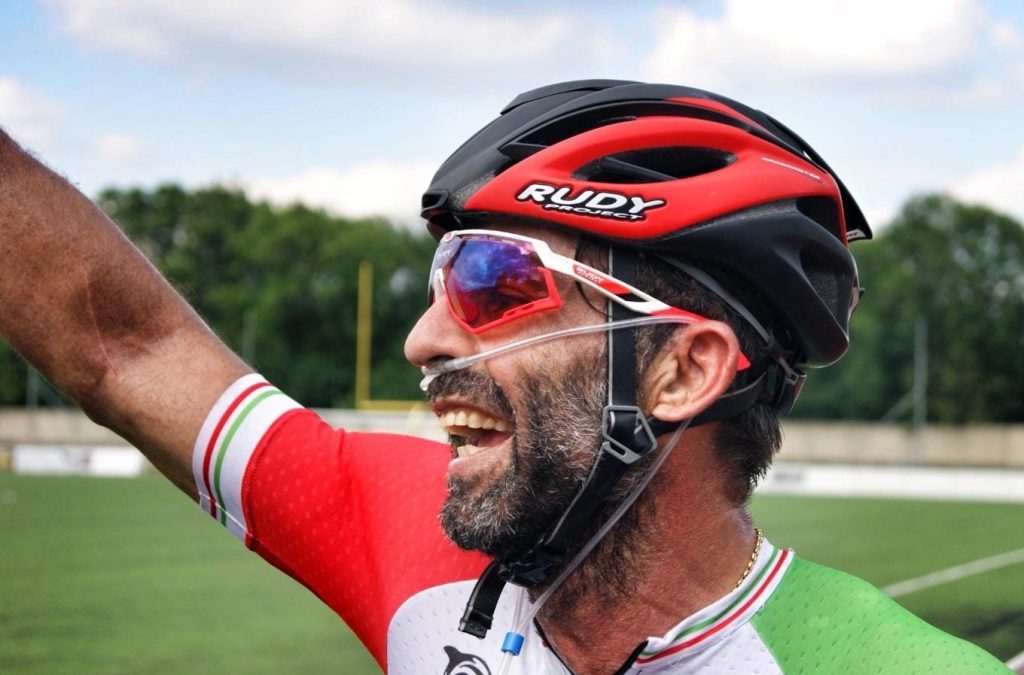
The record set this past Sunday in Rivarolo Canavese consisted in one hour of pedaling on his tricycle and the independent FORZA PURA MagneticDays bike cranks – completely independent from the bottom bracket. It was a personal success, and has even more value if we consider the many “hitches” to accomplish it: first of all it was done on the athletics track, which surface is not smooth and therefore not ideal for bikes; then the vehicle, a tricycle, which at high-speed risks overturning at any time; and finally the completely unlocked FORZA PURA independent bike cranks which require a significant muscle work, expecially protracted for 60 minutes. To monitor the test and analyze the data was XSEOS “Technological Innovation” TEAM of Brescia led by Franco Boldi, a leading software company in the financial and health sector, that for over two years has developed a non-invasive system able to observe vital parameters of people, with the aim of improving their quality of life from all points of view.
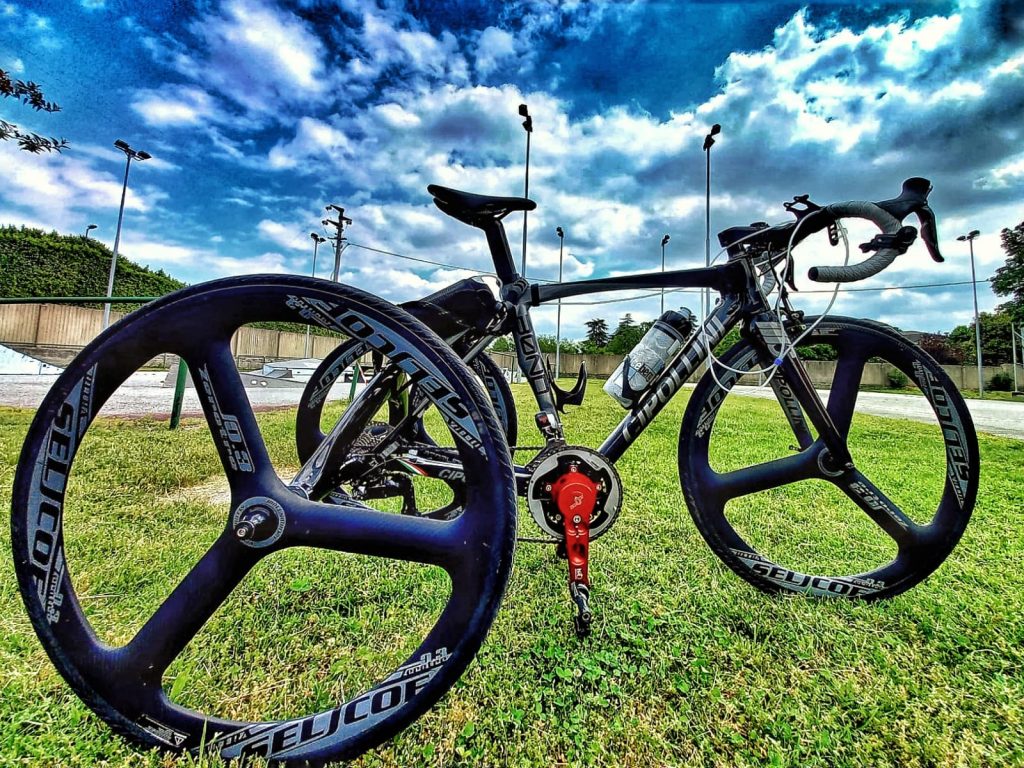
“It was not a struggle but a moment of absolute freedom – Colonel Carlo Calcagni said immediately after the test – I must also thank MagneticDays for supporting me with the innovative independent FORZA PURA bike cranks, a concentrate of technology capable of involving all muscle groups, significantly improving pedaling efficiency and offering the athlete a totally new way of perceiving pedaling, training muscle strength and, at the same time, mental strength. The peculiarity of FORZA PURA in my specific case, is to normalize my pedaling so that I don’t feel the tremors due to sclerosis and Parkinson’s”.
Carlo Calcagni’s tricycle was also equipped with the brand new “Tannus Airless” tires from Tannus Italia: airless bicycle tires that guarantee performance comparable to that of traditional tires. The innovative Aither 1.1 compound allows having a 100% puncture-proof bike tire without sacrificing performance and comfort. The President of the Piedmont Region, Alberto Cirio, personally congratulated the great champion, inviting the Colonel to return to Turin as soon as possible to set a new record and promote a further message of strength, courage and hope for all people living with difficulties.
Jacek Berruti is one of those people with cycling in his blood. A true heroic cyclist. He had a good teacher, his father, Luciano, who gave him courage, foresight, goodness and an unbridled passion for the essence of cycling: a way to have fun and create harmony between people. This is why, on his birthday, we share a little story he wrote just before the beginning of spring. A reflection linked to an experience in which anybody could find themselves, with their human limits, but with the desire to always get better. Because cycling – whether it is for training, competition or any situation linked to healthy competition – is, above all, the desire to try again, to enjoy a magical moment that only a frame and two wheels can give you. Happy reading and.. happy birthday Jacek!
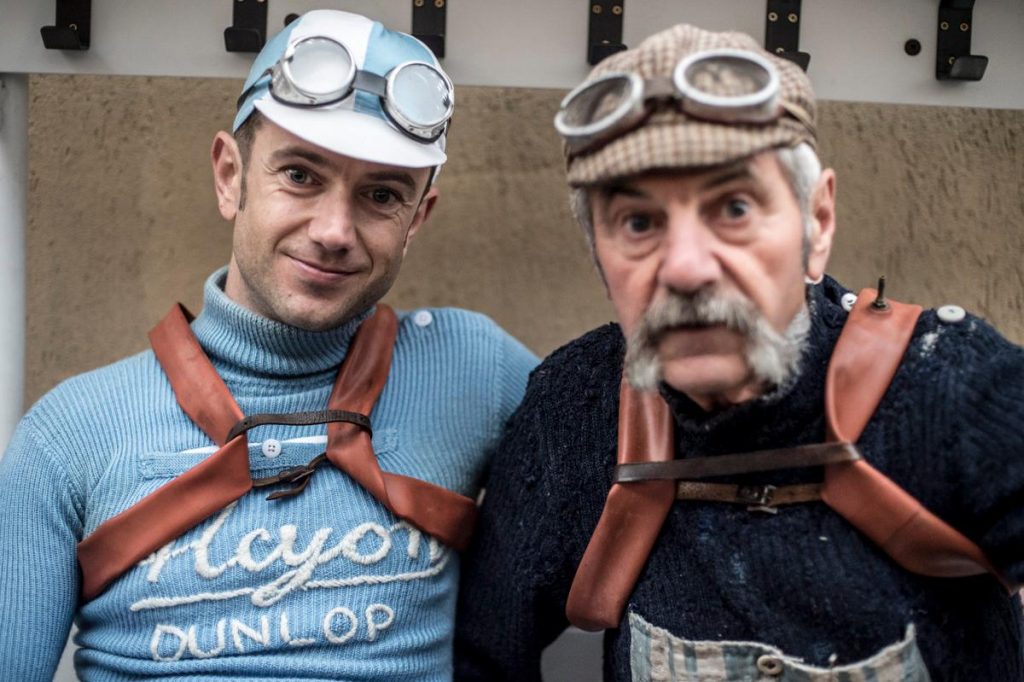
“This happens weekly: as I leave work, my main thought is to get home to get moving. To unplug and recharge the batteries. It is evening, it is dark outside. I spent eleven hours away from home, and now I’m looking for a challenge that can really make me feel alive: so I turn to that multicolored tool that is the MagneticDays Jarvis smart trainer. Ready, set, go: cream on the saddle, towel, sweatband and the right playlist, let’s go. Intensity training, I feel it immediately: my heartbeats are high; my breath becomes a little short already during warm-up. Minutes go by, the going gets tough, too much. At minute 25 the AC/DC ‘screaming’ in my ears are not enough to keep me going. Not even the photo of my dad in front of me; I don’t want to, but I know that sometimes insisting can cause harm: so get off, give up and ‘see you tomorrow’ is the only choice. Usually giving up is not an option during my indoor and outdoor workouts. But so it is this time. I get down.
Defeated, I think that perhaps I was too tired to train. Maybe I’d better respect the recovery times: so I will put this behind me and try again tomorrow. The next day comes. Cream, playlist, bla bla bla: minute 23 this time. Can’t do it. I curse, I stop the training, I get down and I wonder why. Can the meal plan I am following to the letter affect my performance? Yes, I have a food plan: I am training less than usual and I try to stay in shape only through what I eat.
I decide to write Luca Bianchini, my MD Coach, a man of infinite experience. I explain what happened. He tells me I’m ‘low on carbohydrates’, and it is normal for my performance to drop: “you have to decide what your goals are”. So I pass the ball to the nutritionist, who patiently explains to me in detail the wellness and health goals we had set. Mind you: I said well-being and health, not performance or results, I leave those to somebody else. And, if I do reach them, it will only be an indirect benefit.
I return to Luca, who resets my workouts with a lower intensity percentage, and who assures me that soon, with little careful changes in my nutrition, I could have nice surprises. And I sure did! You never stop learning: this is yet another demonstration. I had put together a micro cosmos of sport-health-wellness that opened new horizons for me. The added value is having a coach who can personalize and constantly readjust the training to best suit my needs and goals. I’m being a “guinea pig” for myself and I like it, I enjoy it.
I have the right tools, I have the right people around me and I am very, very lucky. For the record: with the new settings I finished the training as expected. The sweatband was back on, the playlist was “right” again and my “ego” gave a big sigh of relief, which is a reminder that every now and then, feeling at peace with yourself matters the most”.
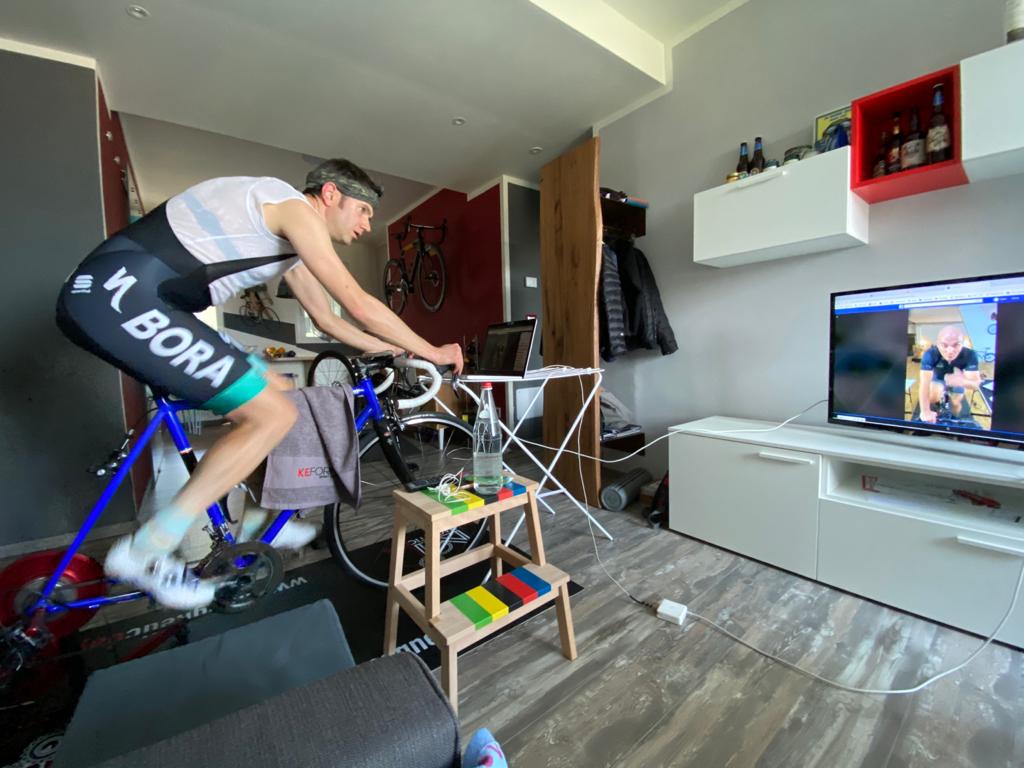
The use of special bike cranks for a workout that involves all the lower muscular districts is not yet a widespread practice among amateur athletes. But the FORZA PURA independent bike cranks are elevating the concept of pedaling to a higher level: it is not only fun but also a new technique aimed at improving efficiency and performance in the medium-long term. In fact, these new cranks, designed by MagneticDays in collaboration with the endurance champion Nico Valsesia, replace the classic crank system with a new one, which is “independent” from the bottom bracket. This offers the athletes a totally innovative way of perceiving not only the pedal stroke but also their own position on the bike.
With FORZA PURA bike cranks all muscle groups involved in the 4 phases of pedaling are trained selectively, in particular those which – in most cases – are almost never used. And speaking of Nico Valsesia, we reached him by phone to ask him three questions and to better understand both his personal use of the FORZA PURA independent bike cranks within a weekly training plan, and what benefits he is obtaining in cycling and running.
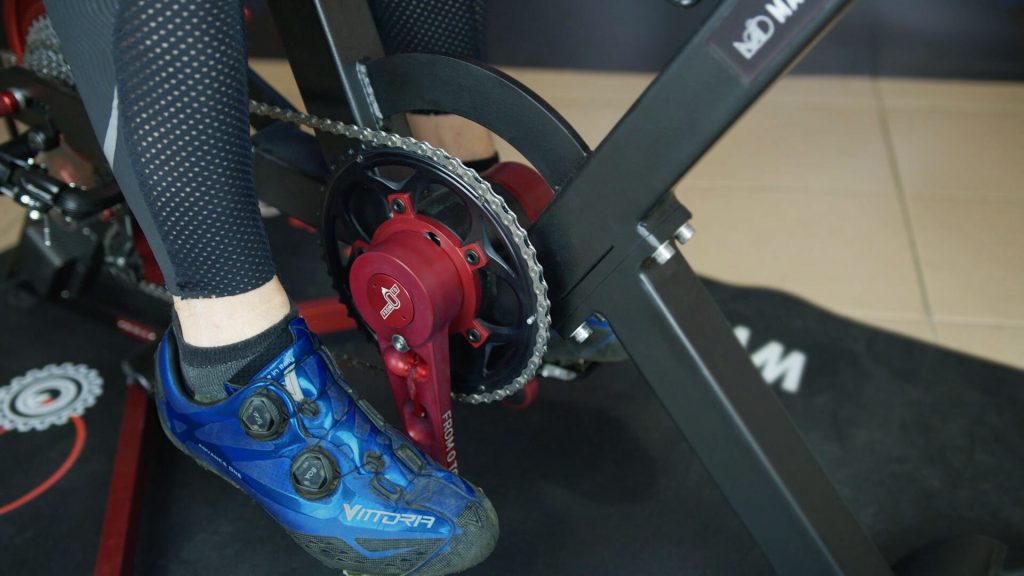
As a user of FORZA PURA bike cranks, what is your perception of load during a training session so far? And what benefits have you noticed in cycling and running?
Let me begin by saying that I use FORZA PURA bike cranks both indoor, on the JARVIS smart trainer, and outdoor. I would like to specify one thing: the initial issue is the load, and this is an aspect that should not be underestimated. The cranks are equipped with a Fast & Easy locking / unlocking system that allows you to switch easily, immediately and safely from the classic mode to the “independent” mode. It is clear that you need to gradually get used to a different work load which is, in some aspects, harder and more tiresome.
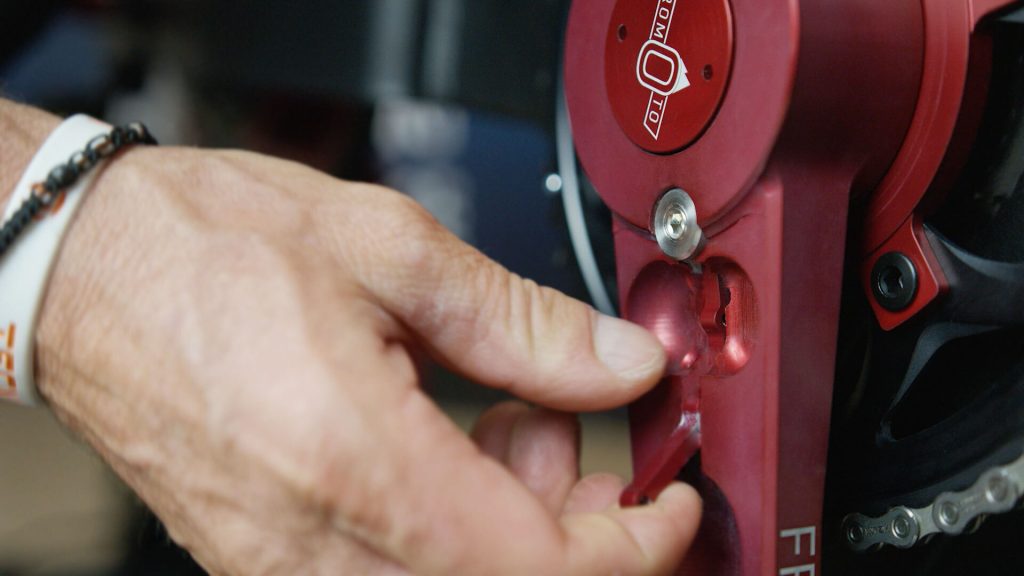
By completely unlocking the FORZA PURA bike cranks from the bottom bracket, specific workouts can be done on one leg or on both. This aims at improving pedaling efficiency and reducing the thrust-traction alternation that determines the oscillation of the power expressed on the pedal. Simply put, FORZA PURA forces the athlete to stay straight on the saddle without unbalancing, using mainly the core region with a better distribution of forces.
As for the perception in terms of load, it is important to understand that during the first month of use you might get frustrated, but it is completely normal for those who have never used a product like this. As far as the perceived benefits in cycling and running I would say we are at 50/50, if not even something more in running, but the effects can be seen after about a month and a half of use, the time necessary to dispose of the loads. Obviously, the disposal time can also vary, as it depends on how each individual responds “physically” to a way of pedaling that really involves the whole the muscle groups involved.
What is your typical training day with FORZA PURA bike cranks?
As mentioned earlier, it is a good idea to have a gradual approach before planning a typical training day with FORZA PURA. This is to gradually stimulate muscles such as the hip flexor and femoral muscles which are normally little or not stimulated at all. When the loads are disposed of, after a month and a half or so, it is possible to start planning workouts within a weekly plan. FORZA PURA could be in fact considered as a “real gym” enclosed in a pair of bike cranks. It allows you to develop quality training not only in terms of pedaling but also in the abdominal and lumbar region, and this does not normally happen on a bike.
As far as the heart goes, the use of FORZA PURA bike cranks implies an increase of 10/15 beats. This is the reason why you have to proceed step by step and give your body time to recognize what is happening at the muscular level. In my experience, you should never stop using FORZA PURA, not even in the racing season. During the autumn-winter time, for example, or from the off season to the beginning of preparation, I would recommend 3 easy outings a week for the first month and a half, divided as follows:
- first 20 days: constrained mode for the first 15 minutes as a warm-up and then 15-20 minutes maximum in free mode;
- next 15 days: constrained mode for the first 10 minutes as a warm-up and then 25-30 minutes maximum in free mode;
- following 10 days: constrained mode for the first 5 minutes as a warm-up and then up to 40-45 minutes at most in free mode according to your needs and feedback.
When the racing season begins to approach, I would recommend two maintenance outings per week lasting 45 minutes, all in free mode. For example, if you have two races within 3 weeks, you could:
- first two weeks: free mode for 45 minutes
- last week (pre-race): relaxed
Once the FORZA PURA bike cranks become part of the athlete’s life, or rather when that “muscular feeling” has been established, I recommend to perform 3 2-hour rides per month, always alternating the two modes of use. In fact, it is good to get used to the different sensations that are perceived when the cranks are locked to the bottom bracket (constrained mode) and when unlocked (free mode), just to understand how and how much the muscles involved in pedaling work. These outings, different in objective and intensity than those described above, could be organized as follows:
- warm-up phase in constrained mode for the first 15 minutes;
- work phase (exit) in free mode for 1 hour and 30 minutes;
- cool down (and return home) in constrained mode.
When and to whom do you recommend FORZA PURA bike cranks?
The best thing that you can do with them is to USE them: FORZA PURA bike cranks must be used. As I always say, you have to have the desire face a challenge. If there is no desire to work hard, there is no sense in using them. In the first month and a half it will be normal to be fatigued, but after disposing of the loads everything will become easier and more fun. It is a bit like tackling a climb by bike or running. The effort you feel is nothing compared to the joy of reaching the top. And speaking of fatigue, pedaling uphill with FORZA PURA in free mode is easier than on a flat land, because the strokes are less and the core supports the pedaling better, but at the same time it is even possible to feel all the muscles involved.
To whom do I recommend FORZA PURA? There are several “beneficiaries” of this simple but also totally innovative product. The first are those who want to struggle and improve. Then there are those whose legs have different strengths, due to a stop or recovery after an injury for example, or due to dysmetria. By using FORZA PURA, you can make the most of all the muscle groups involved in the pedaling phases.
And then there are the amateurs. In my opinion FORZA PURA is more suitable for two types of athletes: the triathlete and the runner. In triathlon, with FORZA PURA you work indirectly on reducing the impact in running, precisely because the triathlete gets used to the change in conditions between cycling and running. Without forgetting the aspect of balancing the position on the saddle and pedaling, which consequently allows less energy consumption. Therefore, even the pure runner can and must consider “alternative” training with FORZA PURA bike cranks.

On the occasion of the Italian Bike Festival a few days ago, several celebrities from the world of sports visited the MagneticDays stand to get together with the whole team and have a chat about indoor training, winter cycling preparation and seasonal events for 2020/2021. Among them was Alessandro Vanotti, Italian former professional cyclist with 9 Giri d’Italia, 5 Tour de France, 5 Vuelta de Espana and 1 World Championship, and today Coach and testimonial for MD. This gathering was an occasion to fine-tune the last details of the Vanotti Bicycle Camp 2020/2021: the project, dedicated to amateurs, offers the magic adventure of a professional team’s retreat on the road, combined with the experience of an active cycling vacation: “Training with quality is possible – said Vanotti – and this is what I try to transfer every day to all those who ride with me. That’s why I joined the MD family and this team; I saw a very high level both on the technical preparation and the human factor, two ingredients that will certainly bring value to my project.”
MD Coach Luca Bianchini – who will support Alessandro Vanotti during the camps – wanted to go into more detail about some aspects of the Vanotti Bicycle Camp. Here are some key points of their conversation.
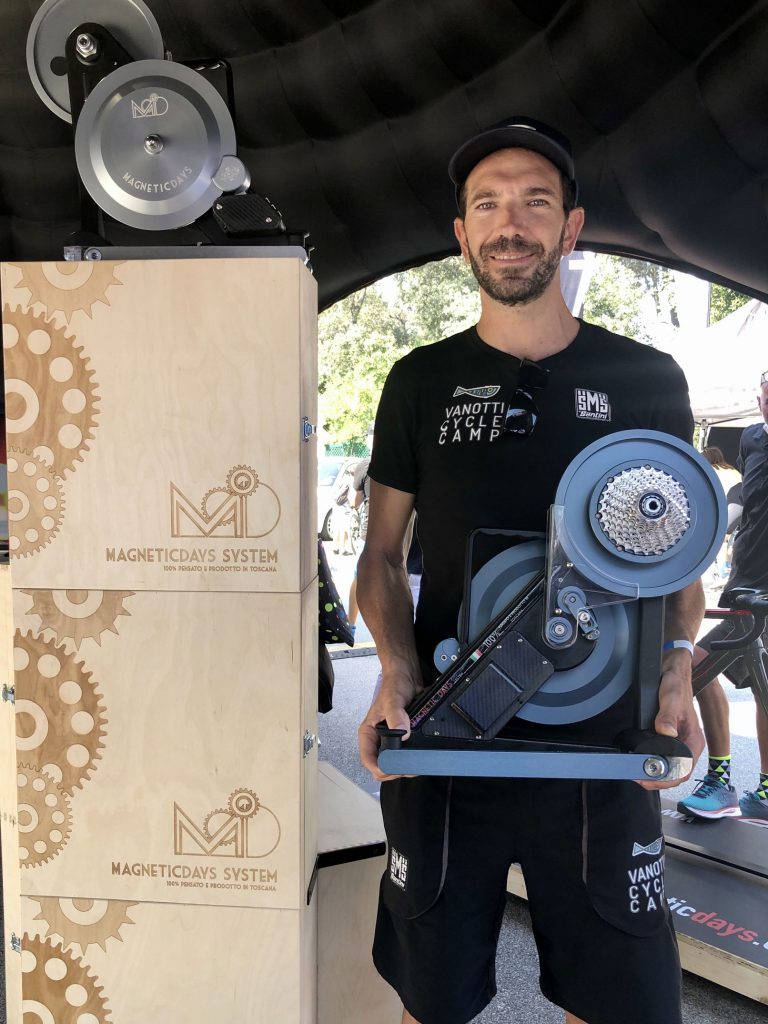 The Vanotti Bicycle Camp will start soon and I will come give you my support. How will the individual stages be organized?
The Vanotti Bicycle Camp will start soon and I will come give you my support. How will the individual stages be organized?
Your support and that of MagneticDays will be invaluable. In fact, you and I will welcome customers as MD staff and together we will evaluate their physical condition at that precise moment. The aim of this is building a work base for the following days by dividing the group according to each individual’s need and workload / volume. This will allow us to have excellent data to start from (Watt, Newton and specific RPM), so that we will be able to plan “perfect” road rides, that is to say calibrated, “tailored” rides. Thanks to MD, in fact, we have unbelievable data available right before starting the work with the group, who is therefore in the best condition to live a quality cycling experience.
So not just a division into a group based on one’s abilities but also aimed at the projection of the various paths to be structured?
Of course. Based on the data that we will collect during the incremental test, we will have both the possibility of arranging two types of routes or of riding the same route in two different groups according to current condition of the participants. This in order to ensure everyone can have fun, stay together and finish the course in an optimal manner and be satisfied with the work done. Furthermore, I will be present and up close in all the outings to give technical suggestions, and help everyone improve their riding. This is because everyone is different and has a distinctive response, and the goal is to work well, grow together and team up, just like in a real professional team.
What do you want athletes to bring home after having lived your bicycle camp?
First of all a unique experience, where everyone feels part of a real team and feels a bit like a professional athlete. I don’t mean in terms of performance, but in terms of approach to the type of work behind, for example, a World Tour team that comes together to prepare a great competition.
Cycling, especially today, is not just pedaling but much more. What’s your point of view?
I agree. The Vanotti Bicycle camp’s objective is the 360-degree cyclist, considered not individually but within a team. Your support at the camp will be precisely for this reason, with specific evening training sessions dedicated to the MagneticDays indoor personalized training methodology. In addition to passion, we try to give something more with gatherings dedicated to training, in this specific case thanks to your experience as an MD Coach. The ultimate goal is to be able to accurately capture all the needs of the group regarding the day spent together. Vanotti Bicycle Camp together with MagneticDays are the difference that makes the difference!
In this historic moment, with the world pandemic and all the associated limitations, many people are dedicating more time to indoor cycling. Sports help you fill your days, strengthen your body and your mind, optimize your time and keep yourself in good health. However, some people are beginning to show signs of impatience with the restrictions, and this impatience also turns into a hyperkinesia (an increase in muscular activity that can result in excessive normal or abnormal movements) in terms of training. It is known that sport is addictive and doing without it for a long period of time causes side effects comparable to the ones due to abstinence from substances such as tobacco. The healthy remedy, therefore, is to continue to practice sports, without “overreaching”. Overreaching is what scientists define as an “accumulation of stimuli, whether from training or not, which results in a short-term decrease in performance, with or without signs or related symptoms (physiological or psychological) of a poor adaptation, and where the recovery of performance can take several days or weeks.”
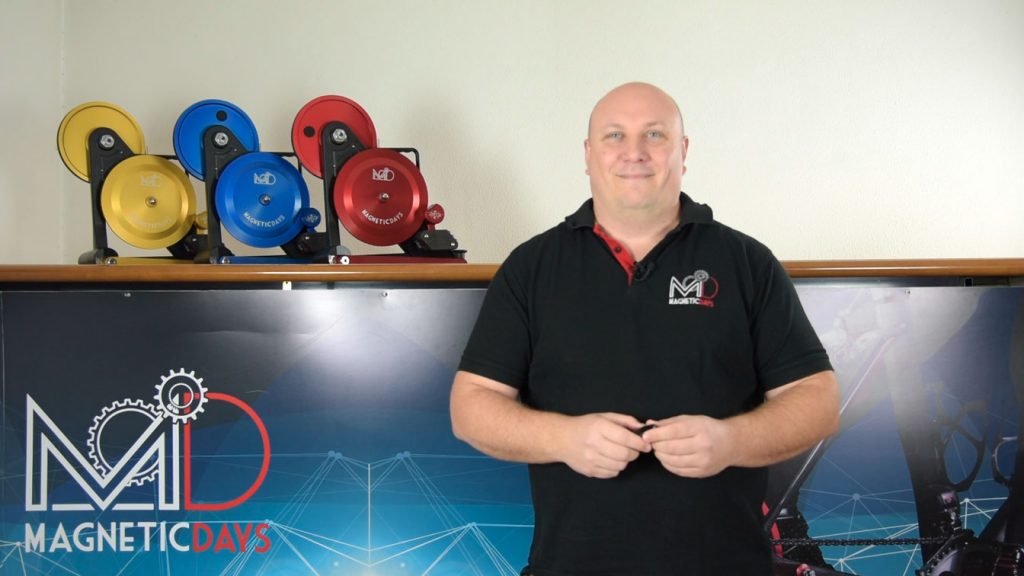
MagneticDays Coach Luca Bianchini offers us an interesting food for thought: “If in a normal day physical activity covers a part of the time, in this particular period in history the percentage of that time increases. The risks produced by an increase in physical activity at home are sometimes unpleasant. The intensity of indoor cycling is certainly greater than the outdoor one and this implies longer recovery times. Excessive sweating leads to a state of chronic dehydration that must necessarily be compensated for. The return to homeostasis is sometimes longer than normal. The first discomforts that are being observed due to the increase in physical activity are latent – continues Coach Bianchini – but they do not go unnoticed to a careful eye. If we used to train 3 or 4 times a week, now we train 7 days a week. Our body is not used to keeping up this rhythm and responds with fatigue. The first organ to give us a signal of this state is the heart. Heart rate struggles to drop adequately during the recovery phase, and stays high even during rest. In maximal efforts, then, it struggles to reach the usual peaks. This is where the use of a valuable tool comes into play: a heart rate monitor. The more advanced ones also provide cardiac variability, data that allows you to evaluate actual recovery. If paying attention to these tools is sometimes underestimated, the lack of serotonin can be stronger stimulant than common sense. If proper attention is not provided to recovery, many people will suffer from chronic overexertion at the end of this period. And this state is the prelude to overtraining, which is a real pathology.“
How to avoid overreaching
Expanding on what Coach Luca Bianchini just talked about, how can you avoid overreaching? And what are the recommended practices? “First of all – continues Coach Bianchini – the variety of training loads: at each high-intensity workout it is necessary to alternate two recovery workouts, in which the heart rate or the reference watts remain under the indications of zone 2 or below 70% of the heart rate threshold. Furthermore, drinking more water than usual, not all at once, but increasing the consumption by at least half a liter (even a liter) throughout the day, is recommended. The body needs water, not only during the indoor cycling session, but also immediately after, and it is even better to add a soluble preparation of salts (magnesium and potassium) and essential amino acids. It is also advisable to take the same supplements right before bedtime, to prevent the onset of nocturnal cramps. It might seem obvious and outdated, but I feel the need to reiterate a concept that I really care about: it is precisely during rest that improvements occur, not during training. Recovery is just as important as training, if not more. Following the instructions of a coach is essential to ensure the correct management of training during the week. If we want to reach the competitive season in the best shape possible, we need to use our head, not only our legs.”
Spring arrived well before March 21st this year, although these last few days, winter is still playing up. Now more than ever, it’s necessary to try and optimize our day in the best possible way. We all are more aware of how personalized indoor training is the best solution, sometimes the only solution, to keep fit and give “oxygen” to the mind and body. It is also a good opportunity to focus on “quality”. Thanks to the help of technology, training on bicycle rollers (aka smart or bike trainers) can satisfy a number of needs at all levels, from general well being to perfecting performance. And a useful reminder: rest and nutrition, if managed at best, can be a decisive factor in keeping in shape.
The benefits of indoor training on bike trainers
Among the main healthy benefits of indoor training on smart or bike trainers we have the reduction of stress and the improvement of cardiovascular health. An indoor training session on bike trainers produces a release of endorphins in the brain, natural neurotransmitters produced by the brain and responsible for improving mood, lowering stress levels and boosting the immune response. And we can imagine how this last factor is particularly crucial to keep our immune system efficient. The release of endorphins is something that happens during any form of physical activity, and indoor cycling is no exception. Training on the rollers, in fact, not only stimulates blood flow and the production of new brain cells, but is also a remarkable activity from a cardiac point of view. The alternation between moments of intense effort and lighter ones, allows you to vary the heart frequency and to create new stimuli. If this is true for a classic indoor cycling activity, it is even truer with a personalized training program such as the one developed by MagneticDays’ HTT (High Tech Training) methodology.
Stimuli and benefits of a personalized indoor training
Starting from the assumption that cycling is essential – as 4Bicycle friends often say – a personalized indoor training allows you to create continuous stimuli for mind and body, essential for bettering your physical condition and performance step by step. In fact, there are many factors to consider when we compare indoor training to outdoor training. Even more so when we talk about a targeted training that aims to develop a specific part of the performance (strength, threshold, over threshold etc.) and to achieve the maximum result and well-being. And this is exactly what we are talking about here.
The MD HTT methodology allows you to understand what the athlete’s physical condition is at a specific moment, his/her possibilities, how much you can or cannot push, and which aspect you have to work on. This is why personalized training is not just a “chart” but it is the ability to understand what is best for the athlete in that precise training session, what optimal routine to follow and the recovery time necessary.
Newtons in indoor training on MD JARVIS bike trainer
The distinctive benefit of the MagneticDays indoor training system is to split the Power (Watt) data into its two fundamental components: Strength (Newton) and Cadence (RPM), and to train them specifically, individually or in combination. The same subjects expressing the same power can be completely different in terms of Newton and RPM expressed in pedaling, thus requiring completely different personalized workouts. An example: let’s consider an athlete who, at 90 rpm, produces wattage of 250 Watts (26.5 Newton). With a pedaling pace below 90 rpm, for example 85, it will take 29 Newtons to produce 260 Watts, thus exerting more force. On the contrary, exceeding 90 pedal strokes, for example 100 rpm, it will take 25 Newtons to produce 260 Watts, thus developing greater agility. MagneticDays allows you to always work with a fixed value (Watt or Newton) depending on whether you want to favor power or strength. Each of these steps creates a different stimulus that allows you to face each workout with different but targeted objectives.
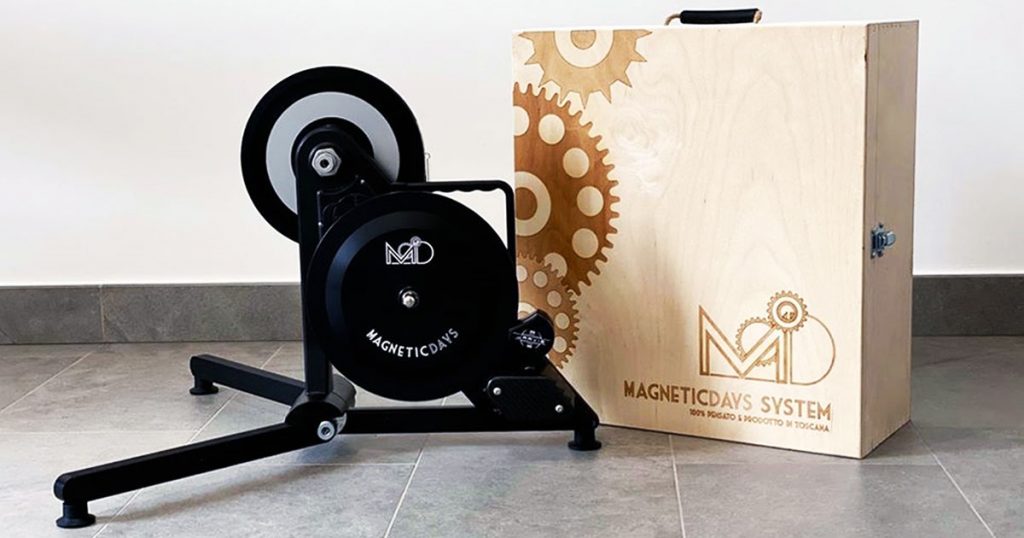
Training indoor in Dubai? We talked about with David Labouchere, a top age-grouper (55-59) in long course triathlon, who told his personal experience with MagneticDays smart trainer. He came from a background of rugby and running for fitness, and found Ironman racing only when he was 47 years old. David has now been competing for 10 years and while he has a recent two hour Olympic PB, he prefers to race long. He was 10th in age in Ironman World Championship in 2018 and allowing for a 45 second “mechanical” when he lost his chain, he had the fastest bike leg. He is again qualified (for the sixth time) for the IMWC this year and hopes to podium!
Training indoor in Dubai
Now David lives and trains in Dubai where he owns a gym, a coffee shop and a sports therapy centre. But what is the best way to train in Dubai? Average temperatures in the Middle East at this time of the year are in excess of 40°C, so David either rides at night, or indoor on a trainer, or both. He has a JARVIS MagneticDays smart trainer and believes it to be the best bike trainer for him. It is quiet and accurate and he loves the separation of Power (Watt) by Force (Nm) and Acceleration (RPM) as he is looking for every small advantage in the lead up to his race in Kona this year. David also enjoys the variety of scientifically designed workouts available to him and feels that this eliminates any junk km from his 20-28 hours of training each week.
“Some athletes give up triathlon for the summer in Dubai – David said – others become nocturnal but even then they don’t get full value from their training hours as the heat lingers in the desert. The answer is a top bike trainer, but for me there is only one, MagneticDays smart trainer.”
The indoor cycling concept in UAE and MagneticDays experience: 3 questions for David Labouchere
We asked 3 questions to David Labouchere – one of the first triathlete to test MagneticDays smart trainer in Dubai – with the goal to understand the indoor cycling concept in UAE:
- What’s your idea of indoor cycling and training indoor for a triathlete? Training indoor concentrates training value into the shortest possible time. And if it’s a quality training, then it becomes an important weapon for an athlete who lives and trains in a place where the climate is one of the main factors that influences every workout.
- In your personal opinion, how an indoor training plan with MagneticDays smart trainer can improve the cycling performance? I’m not yet sure, but it feels like the JARVIS is serving up a very specific, personal menu of work designed for me and my physiology, rather than a general solution.
- What were your first impressions after trying MagneticDays smart trainer? Wow! All of these data are the key. They are accurate and addictive!
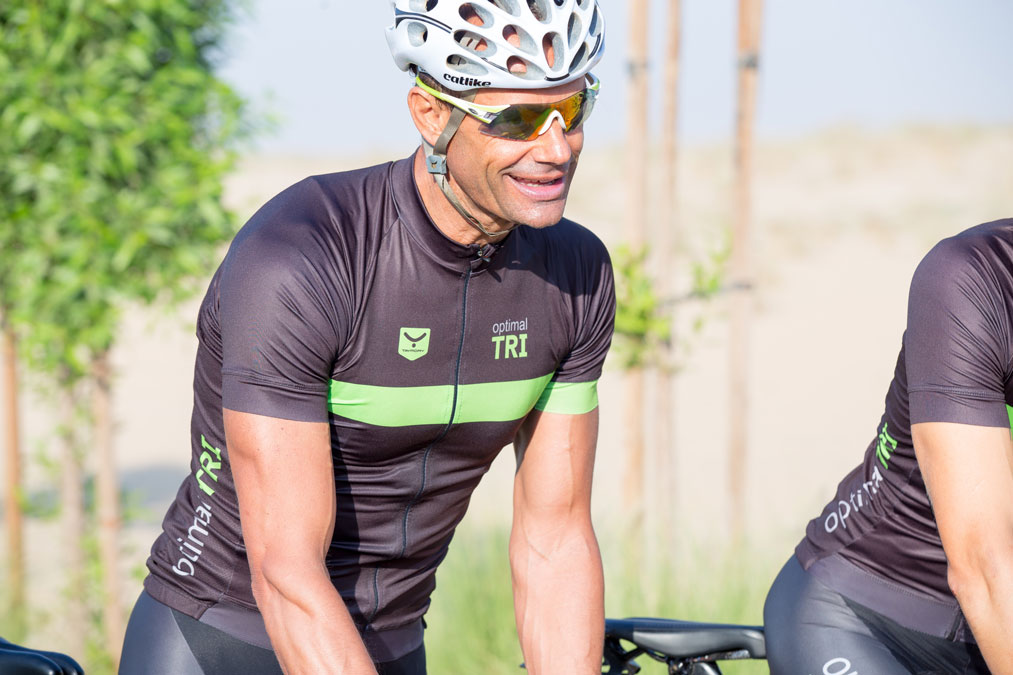
In this third and final part dedicated on optimizing the first three months of an Ironman distance triathlon season, Coach MD Luca Bianchini outlined the guidelines on how to set up a weekly training schedule for in Ironman Triathlon. “In the various books on training methodology – says Coach Bianchini – we talk about training cycles. The practice is to divide these cycles according to the days of the week and the pattern of months and weeks. Monday indicates the start of a training cycle and Sunday marks its end. Based on typical weekly commitments (for example working hours, swimming pool times, etc.) the training program is divided into 7 days. A micro-cycle (normally assimilated to a week of training) is identified as the shortest cycle in which all the conditional skills such as strength, speed and endurance are trained.”
From these initial indications, it is presumed that the minimum number of workouts to be sustained per micro-cycle is 9. “If we also want to include 2 physical training sessions – continues Coach Bianchini – which are useful to prevent injuries and improve performance, we go up to 11 workouts. But sometimes 11 workouts within a week cannot be performed due to time constrains. If this is the case, an alternative can be to perform the so-called combined workouts, at least 1 per cycle, for a total of 12 workouts.”
Various authors insist on using the week as a reference, but no one forbids extending this time to 10 days. Coach Luca Bianchini, therefore, hypothesizes two micro-cycle modes, the first based on 7 days, the second on 10. Here they are in detail:

as you can see, a high intensity workout is scheduled every day. Following this type of program for three months (even considering that you can modulate the loads) can lead to functional overload.

By extending the cycle to 10 days, however, you can give more room to recovery and aerobic training, an important basis for endurance sports. As mentioned above, this type of schedule is sometimes hard to follow due to the many commitments we all have. The 7 or 10 day schedule needs to be adapted according to the competition date (which is necessarily held on Saturday or Sunday), therefore, Coach and athlete need to work together to find the right balance between all factors.
Assuming there is a race Sunday, the week can be adapted as follows:

In the case of a race on the 7th day of training, the schedule will be as follows:

In the case of a race on the 10th day of training, the schedule will be as follows:

“The use of the JARVIS training system in triathlon – concludes Coach Luca Bianchini – allows you to perform specific training for each distance. There are different steps, from the analysis of the performance model to the planning of training. The continuous feedback between athlete and coach represents the ideal combination to optimize performance. And the collaboration between the MD Coach, the triathlon coach and the athlete is the optimal solution for scheduling training times and plan methods to achieve the desired goal.”
To better understand how functional indoor training in triathlon with MD JARVIS can optimize performance in the first 3 months of an Ironman season, click here.
In the first part of this article we saw how indoor triathlon training with MagneticDays can be successfully used in planning the first three months of training for a Ironman athlete. In this second part we involved MD Coach Luca Bianchini to understand and analyze how to optimize the performance of an Ironman distance triathlon.
Organize your time to optimize performance
Time is one of the deciding factors in optimizing triathlon performance, particularly when dealing with an Ironman distance. And if this is true for professional athletes, it is even more true for amateurs, people who play sports for passion trying to carve out a few hours from a day full of personal, family and work commitments. Here are some factors to consider:
- Number of days to the target race | Let’s assume the race is at the end of June, you will have about 12 weeks of training (90 days). This hypothesis is valid for any race you want to play, not necessarily at the end of June. If the race is in October, just move the month of March to that of July. Joe Friel writes in his books that the three months before a goal race are the most important to have an optimal performance. We are only focusing here on the cycling part and on the personalized indoor training with MagneticDays and based on the type of race chosen, we will focus on consolidating the performance;
- Time available for training | The life of a professional athlete is all about training. The life of an amateur athlete also includes work, family and all other aspects of a typical day. The cycling segment is definitely the part that takes the longest to train, but sometimes you don’t have that time. This is why a training strategy with MagneticDays makes the most of the time available. An hour (or a little more) dedicated completely to improving performance without being bothered by traffic lights, holes, wind against or other cyclists. An hour without distractions and completely focused on the goal.
A good physical structure combined with proper planning allows the athlete to better manage workloads
In order to optimize performance in a triathlon race, it is necessary that the athlete is able to manage the daily workloads well, to train to the best of his/her ability but avoiding the risk of injuries. The factors to consider in this case are:
- Load capacity of the athlete | Each athlete, based on his/her history, can sustain different workloads. If you overdo these loads, you will soon find yourself tired. Through the athlete’s feedback the coach is able understand what the load capacity is. The training analysis, performed by the coach, makes it possible to understand if the athlete still has the ability to maintain the loads or if it is necessary to reduce them. This point is closely related to the following;
- Alternation between high-intensity and low-intensity training days | In a well-done training program it is also necessary to include periods of rest. Intrestingly enough, performance is not improved during the training, but druing the recovery period (that is, when the repair processes, stimulated by training take place). By not respecting this simple principle, you will risk chronic fatigue (initially) until you get to a real overtraining (if you persist). Even though low intensity workouts are often percieved as usless in terms of improving the performance, in reality, in sports such as triathlon, these low intensity workouts are necessary to develop the endurance necessary for the duration of the race. No matter if we are talking about the time of a sprint race or the over 9 hours of an Ironman, medium-low intensity workouts are as important as high-intensity ones.
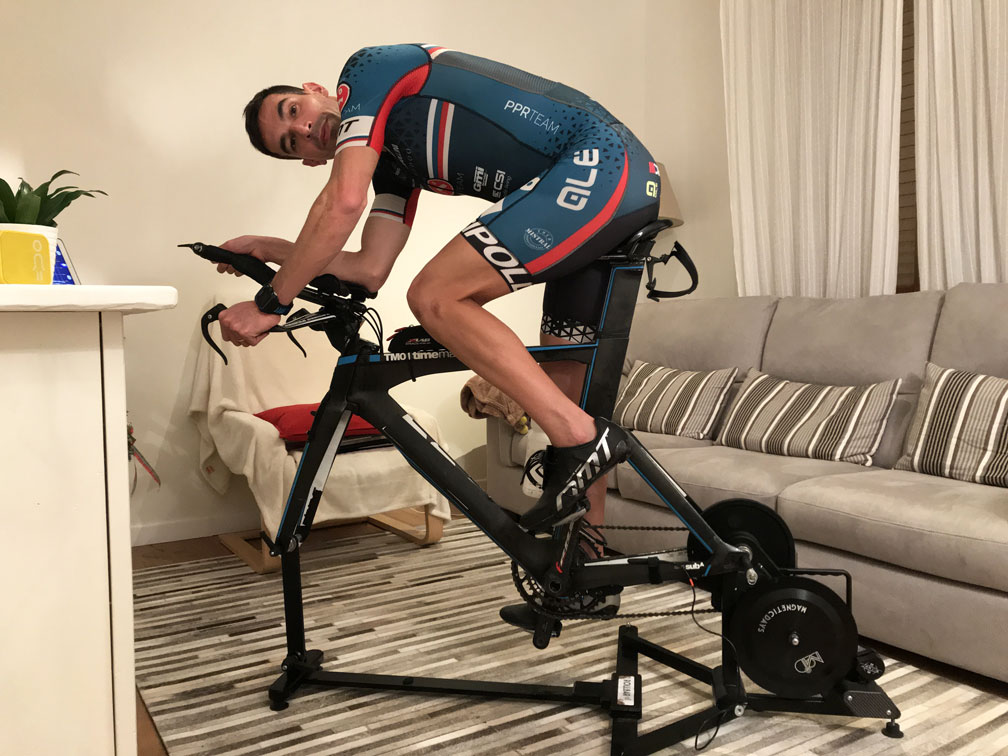
Optimize training and triathlon performance with MagneticDays while having fun
Knowing how to optimize your training also includes the ability to have fun while doing it. Imagine what it might be like to train for an Ironman distance triathlon and do it reluctantly. It would be just a waste of time, also considering the level of physical and mental commitment that must be devoted to it every day. For this reason it is important that the coach and the athlete work together harmoniously, and that the following conditions are respected:
- Planning combined workouts (generally cycling-running) | These workouts are often underestimated because they take time and coordination. Generally, combined cycling-running training is planned because, once the cycling part is over, switching to the running phase seems as easy as putting on a pair of running shoes. But the transition from cycling to running is the most demanding in terms of muscles. Getting off the bike after 40 minutes, or 6 hours for that matter, and then running is an effort that must necessarily be trained. But even going from lying down (swimming) to standing (running to get to the transition area) is something that needs to be trained. Taking your MagneticDays JARVIS smart trainer with you by the pool (if you have the pool’s authorization in advance, that is), not only transforms indoor training into an outdoor one, but also represents an optimal solution for performing combined swimming-cycling. The Jarvis battery guarantees safety on the poolside. And you will be using your own bike, allowing you to have the biomechanical adaptations needed. Also adding the part where you remove your wetsuit and change, allows you to actually train all aspects of the race, and specify even more the T1. Furthermore, using the MD WiFi App on your phone or tablet allows you to perform a specific workout based on the performance model of the target race. Simulating T2 allows you to make training even more stimulating;
- Interpretation of the race performance model | The swimming and running fractions in the various triathlons have few variables, depending on the course. The cycling fraction has many more variables. From the sprint to the Ironman, from a road race to an off-road, the variables are many. Analyzing the performance model allows you to optimize specific workouts. The potential for compiling workouts based on the performance model makes training more and more specific. Many athletes upload the elevation profile of the segments or the entire cycling portion of their races on the web. Taking advantage of this, training on the Jarvis smart trainer becomes much more than a simulation, experiencing the same sensations that will be experienced in the race;
- Optimize the deficient discipline | Those who approach triathlon normally come from one of the three disciplines. For one reason or another, it often happens that one or two of the three disciplines are more deficient than the others. For those coming from swimming, running could be an obstacle. For a runner, swimming is usually the impediment. On the other hand, cycling is the discipline that can most easily be trained (from a metabolic point of view). The technical aspect of the bike is guaranteed by the biomechanical; the driving technique can be learned. The metabolic part can be trained easily. The certainty of being able to perform a personalized workout with MagneticDays, comfortably at home, allows you to improve performance without the dangers of the road.
In the third and last article dedicated to triathlon, we will find out how to optimize the performance in Ironman distance triathlon training. If you missed the first part, don’t worry! Here’s how MD technology can be used successfully in planning an Ironman athlete’s first three months of the season.
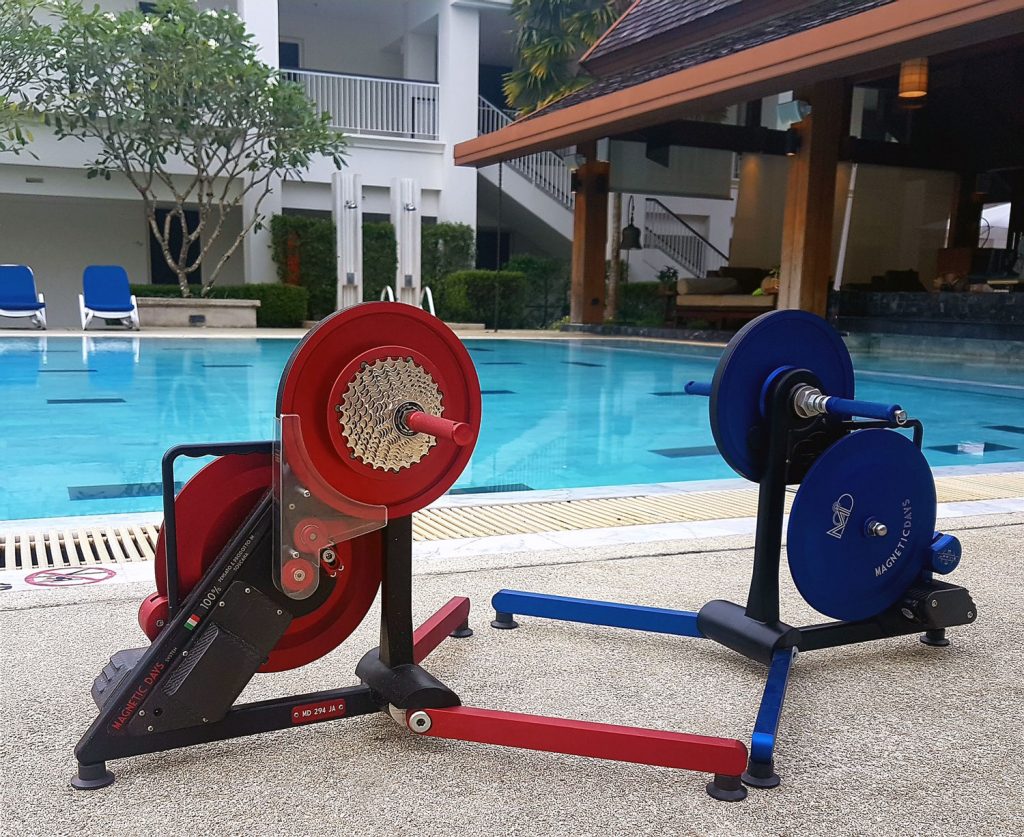 b
b
Indoor triathlon training, especially Ironman distance training, is increasingly present in the life of athletes, amateurs and professionals. If before “smart training” was considered an option for a few, today it is becoming an integral part of a training strategy aimed at optimizing the performance for many. A multipurpose tool like MagneticDays JARVIS smart trainer allows the coach (and the athlete) to introduce specific quality indoor cycling sessions within a weekly schedule.
The use of MD JARVIS smart trainer in weekly indoor training: when and why.
For an athlete, the first three months of each new triathlon season are the most important ones because they test the results of all the hard work carried out during the off season. Once you get to the race, finding the right rhythm, the right pace is key. To do this you need to build endurance, which is gradually developed during each training session. In any triathlon race, especially on Ironman distance, the cycling segment represents a crucial part, certainly the longest portion, and this is why it is fundamental to train it at best without loading the body with exhausting workouts that, in the long run, can only worsen the performance.
“The functional evaluation test with JARVIS – says MD Coach Luca Bianchini – has a dual purpose. It serves both as a verification of the work done during winter and as a starting point for preparing a set of workouts aimed at optimizing the physical condition in progress, and therefore, performance. At first, the new threshold and the respective training zones are identified, both in terms of Watt and heart rate. Then, we analyze the characteristics of the cadence and the over-the-threshold capacity to understand how you can intervene to improve performance. All this keeping in mind that during the first three months of the season the athlete, and his/her body, needs to get used to a more constant pace of physical and mental effort.”
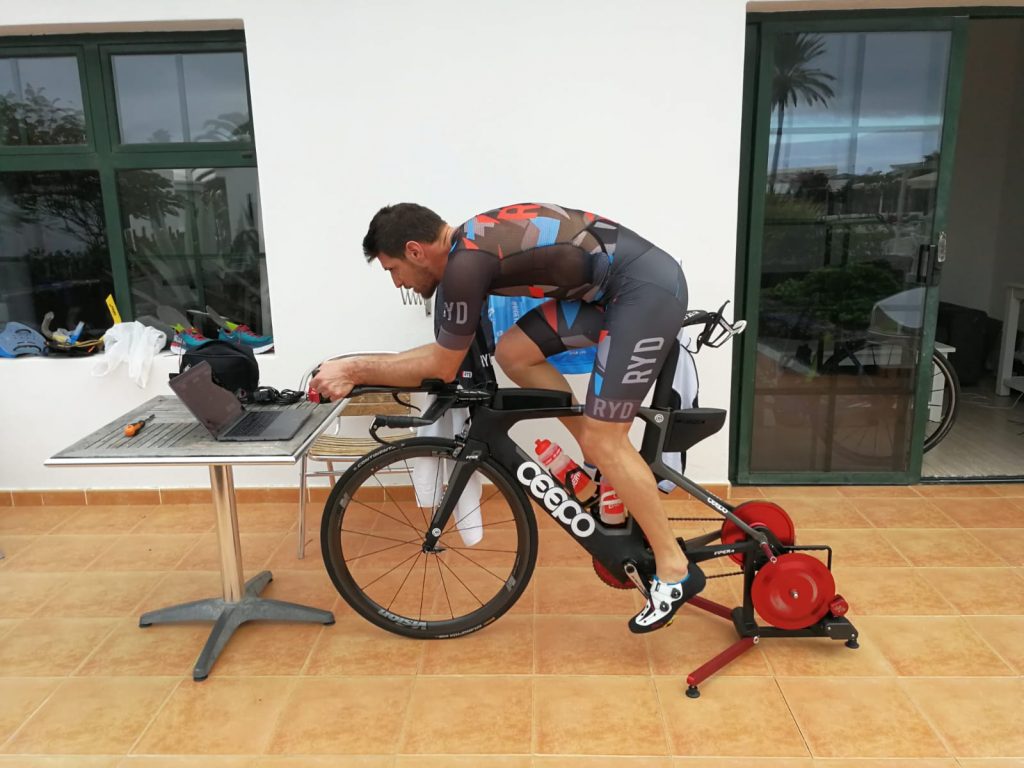
The advantages of a MagneticDays personalized training program
A personalized training program must necessarily start from good planning. The underlying concept of the HTT methodology is to follow the polarized method. This training method consists in investing about 75-80% of the training volume in the aerobic zone, while the remaining is at high intensity. Considering that an amateur athlete spends approximately 10 hours of training for the cycling part (cycling and triathlon), about 7-8 are typically performed on the weekend with long rides. The remaining 2 hours of training should be done at high intensity. These two hours of high intensity training can be carried on MagneticDays JARVIS smart trainer to perform HTT workouts and thus optimize the indoor training program.
“The concept behind every workout – continues Coach MD Luca Bianchini – is to increase and improve performance which, in the case of cycling, translates into the supply of more watt at the same heart rate. Using the heart rate (internal load) as an absolute reference can sometimes be misleading. In case of fatigue, the heart struggles to rise and to modulate based on the watt delivered, while the watt (external load) are always the same and do not take into account the physical state of the athlete. With MD JARVIS smart trainer, the heart can be seen as an internal state control system which follows an external load that the coach is able to verify together with the athlete’s feedback. Increasing the threshold watts is not enough for excellent performance. Theoretically the threshold is the power that we can maintain for about 60 minutes, but not everybody can do this, sometimes because those watts have not been consolidated.”
In this time of the year (from March to June), when the Ironman triathlon season has not yet started, we are in the optimal period to consolidate the performance improved during the winter. The first races will serve as a test to see if the programming has had its effects. Each athlete’s goals are different. There are those who want to compete a race for the pleasure of doing it, and those who want to achieve important goals (from the podium to the Italian sprint triathlon Championship to the final of the Ironman in Hawaii). What unites all these athletes and the variety of their goals is to perform at their top during the competition. The best training for a race is the race itself, but you obviously cannot compete every week and expect a perfect performance every competition. Furthermore, to train for triathlon, where the effort is 100%, you need to follow an even more focused program.
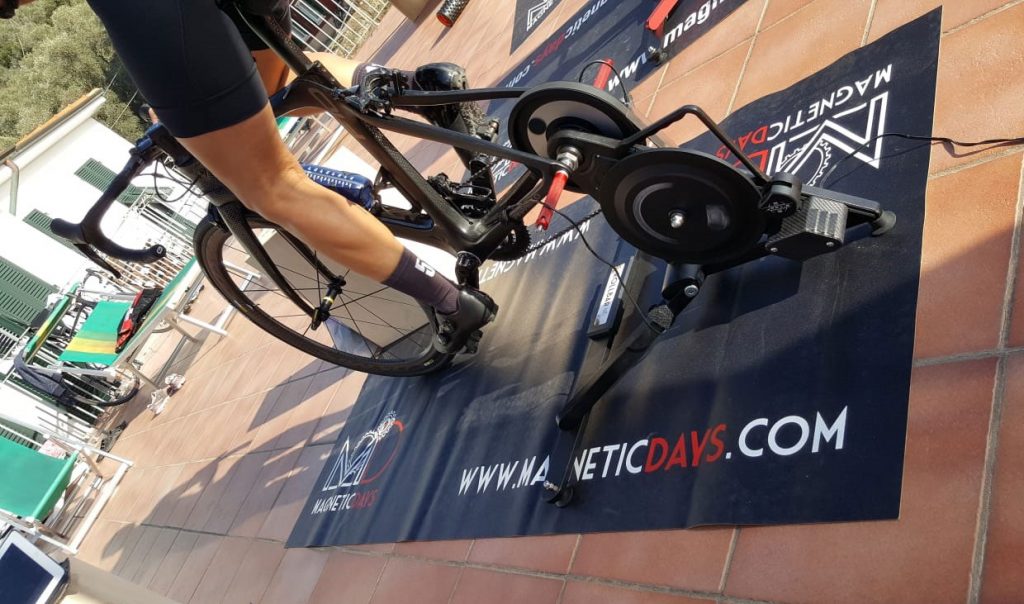
If we are only talking about one of the three disciplines in triathlon (cycling) programming is quite simple, but being able to perfectly modulate all three disciplines is complex. There are some factors that must be taken into account:
- number of days until the target race
- time available for training
- load capacity of the athlete
- alternation between days of high intensity and low intensity
- training insertion of combined workouts (generally cycling-running)
- interpretation of the performance model
- enhancement of the deficient discipline
These are just a few points a coach needs to keep in mind to optimize the annual schedule. In the second part of this article we will analyze how to optimize the performance in triathlon.
The Achilles tendon is the strongest and thickest muscle in the human body but, despite its size, it is also the one most exposed to the risk of injury. There are several causes that can lead an athlete (cyclists, triathletes, mtbikers or runners) to face, physically and mentally, this type of injury, which can involve a thickening or a partial injury in the most fortunate cases, or a break in the most unlucky ones. Here’s how the HTT cycling training methodology can be applied to recovery from partial injury in the rehabilitation of the Achilles tendon.
Recovery times from an Achilles tendon injury
Recovery times for an Achilles tendon injury vary according to the extent of the damage suffered. In the case of a partial injury – which usually involves not just the tendon but the tendon sheath (covering that protects the tendon) – recovery, meaning walking “normal” again, lasts approximately one and a half months, that is between the time in a cast and good physiotherapy. After that, an athlete’s muscle tone can be restored within two weeks with a program that includes swimming sessions and workouts on the smart trainer.
In this regard it is good to remember that muscle memory rarely forgets. In the case of an athlete accustomed to training regularly, recovery times can be shortened even more. The HTT methodology can also offer valid support in recovering from an injury such as the one just described.
Rehabilitation exercises for the Achilles tendon: MagneticDays optimal tool for full recovery
The HTT methodology developed by MagneticDays currently represents the maximum scientific personalization of a workout because it is based on the continuous combination of Evaluation/Delivery of training loads and can be adjusted accordingly throughout the year. This means always providing the type of work required at any specific time and condition. Entirely calibrated on the athlete’s real values at that precise moment, the HTT methodology allows, in a few sessions, to go back to the state of form the athlete had prior to the injury and the appropriate threshold value.
“Returning to training after an Achilles tendon injury, even if partial – said the MD Head of the Technical Area Simone Buracchi – must follow specific steps. The athlete, who has been stationary for at least a couple of months, has to reacquire the physiological movement of pedaling. Before assigning specific exercises, we run both an incremental free pedaling test and the incremental Joule test. On the basis of the values obtained and taking into account that we can have a loss of around 25% in terms of Watts expressed in threshold, the first exercises on MagneticDays JARVIS will be structured in crescendo, with the aim of returning in a short time to the values expressed before the injury. The physical condition of the athlete and his ability to recover also play a fundamental role in the physical and mental response to every single session with JARVIS smart trainer. For athletes who use our indoor training system independently (i.e. without being followed by a Coach), MagneticDays self-calibrating workout, studied in collaboration with the University of Verona, is a very valid option in the delicate recovery phase. In practice, it is a series of protocols optimized to allow the user/athlete to perform a good workout when the optimal conditions for doing so are lacking. If the self-calibrating workout is performed well, it really becomes the most effective activity that can be done in this case, because it is a photograph of the athlete at that precise moment and the workout is adapted to his/her physical condition, accompanying him/her step by step towards a rapid recovery.”
Two months ago we had the great pleasure to win the POR CREO 2014-2020, a project carried out by the Region of Tuscany and the Regional Operational Program (ROP) of the European Regional Development Fund. MagneticDays was selected with its biomedical project named Bio MagneticDays – developed in R.T.I. (Temporary grouping ocompanies) – with the goal of bringing a five-year experience in the world of indoor training, the JARVIS (the one and only indoor training system based on a scientific approach), into the field of medical rehabilitation and to help people with heart conditions, diabetes, trauma patients and all those in need of an actively assisted movement.
This biomedical project has the goal to improve the quality of the MD system, the JARVIS, by developing technological models suitable for the field of medical rehabilitation, and the trial of two prototypes of indoor training systems in water.
Bio MagneticDays Research Project and workout protocols in water
“The Bio MagneticDays Project will see the JARVIS become an instrument able to satisfy both the needs of scientific research and medical rehabilitation – MD CEO Marco Sbragi said – Starting from the study of water mechanics, and implementing prototypes which are being tested by our company.”
A high interest in the Bio-MagneticDays project came from Salaria Sport Village (the largest Italian sports center and second in Europe with over 220,000 square meters of vegetation), where the team, headed by Professor Andrea Passerini Ph.D., is working on specific workout protocols in the water. The aquatic environment has distinctive features, such as anti-gravity, resistance of Water-Bike in the water and variable water pressure, representing the best place especially for particular kinds of subjects/patients (for example obese people), who are strongly impeded in carrying out workouts in “dry” conditions.
Bio MagneticDays Research Project represents an additional plus of MD indoor training system
So far, it has not been possible to provide adequate guidelines for specific workout protocols, because the available technologies did not allow recording some of the most interesting results. Having a system for detecting and supplying workloads while training in water – as MagneticDays does – is a huge innovation. Being able to quantify an immersion effort through the monitoring of parameters such as Power (Watts) and RPM, allows to evaluate the progress achieved over time and to analyze the study related to the physiological-metabolic variations of the subjects under examination. The use of the MagneticDays Water-Bike (W-Bike) prototype will make a considerable contribution to the scientific literature that is still incomplete in this matter.
“We are very proud and honored – Prof. Passerini said – that the high quality of MagneticDays (which has always distinguished itself from the research, experimentation and innovation point of view) has also been recognized at the European level. In our opinion, this is a great opportunity to maintain the high quality offered by Salaria Sports Village and open a new line of research that will certainly bring great results.”
The project is the result of a partnership amongst companies from different trades (precision mechanics, aerospace and railway mechanics, electronics and medicine) with the active collaboration of a University of excellence such as Pisa, particularly the Faculty of Medicine and Department of Cardiology, where a team led by Professor Dr. Carlo Palombo and Dr. Sara Sbragi developed the entire set of incremental test protocols, performed the data collection and made the analyses for later scientific validation.











